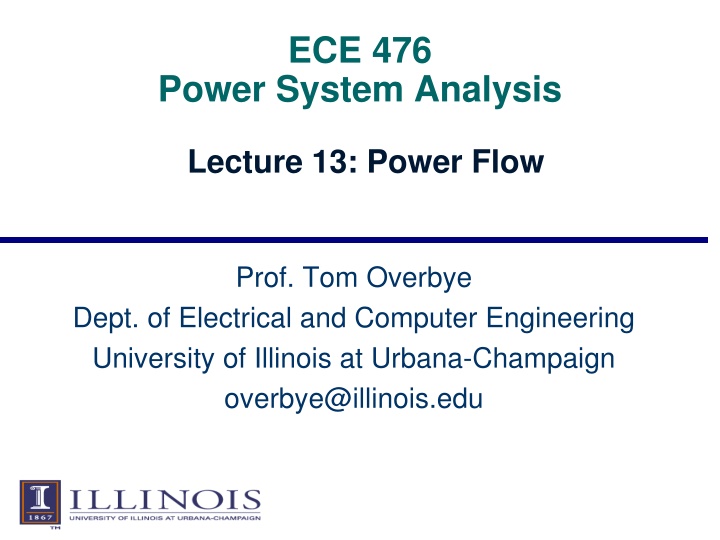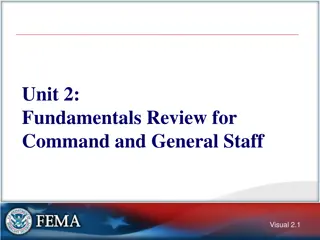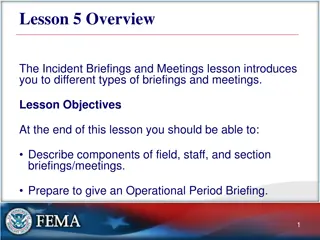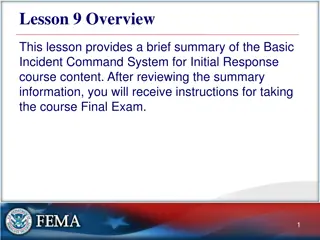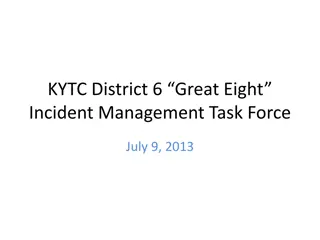Power System Analysis and Recent Blackout Incident in South Australia
In this lecture by Prof. Tom Overbye on power system analysis, Chapter 2.4 and Chapter 6 topics up to 6.6 are emphasized, along with a list of homework assignments. It also discusses the South Australia blackout incident, its impact, and speculation regarding wind power fluctuations. The value of electricity and cost of blackouts are highlighted, showcasing the importance of grid resiliency. Newton-Raphson method comments and multi-variable applications are also covered.
Uploaded on Sep 13, 2024 | 2 Views
Download Presentation

Please find below an Image/Link to download the presentation.
The content on the website is provided AS IS for your information and personal use only. It may not be sold, licensed, or shared on other websites without obtaining consent from the author.If you encounter any issues during the download, it is possible that the publisher has removed the file from their server.
You are allowed to download the files provided on this website for personal or commercial use, subject to the condition that they are used lawfully. All files are the property of their respective owners.
The content on the website is provided AS IS for your information and personal use only. It may not be sold, licensed, or shared on other websites without obtaining consent from the author.
E N D
Presentation Transcript
ECE 476 Power System Analysis Lecture 13: Power Flow Prof. Tom Overbye Dept. of Electrical and Computer Engineering University of Illinois at Urbana-Champaign overbye@illinois.edu
Announcements Please read Chapter 2.4, Chapter 6 up to 6.6 HW 5 is 5.31, 5.43, 3.4, 3.10, 3.14, 3.19, 3.23, 3.60, 6.30 should be done before exam 1 Exam 1 is Thursday Oct 6 in class Closed book, closed notes, but you may bring one 8.5 by 11 inch note sheet and standard calculators Last name A-M here, N to Z in ECEB 1013 McKinley Health Center encourages all students to get their flu shot Details and clinics at http://mckinley.illinois.edu/fluclinic 1
In the News: South Australia Blackout On 9/28/16 at 418pm (local time) South Australia experienced a state-wide blackout Load at the time of the blackout was 1900 MW (850,000 customers, 1.7 million people) South Australia was importing 600 MWs from Victoria Initial investigations indicate loss of 275 kV lines due to storms Some speculation about wind power fluctuations being a potential cause Sources www.aemo.com.au/Media-Centre/Media-Statement-3---South-Australia-Update, jo.nova.s3.amazonaws.com/graph/energy/electricity/electricity_grid_australia_2009_s.gif 2
Value of Electricity and the Cost of Blackouts The derived value from electricity (in say $/kWh) varies widely (e.g., during exams engineering students value the small kWhs for their calculators very highly) Costs of blackouts can be quite nonlinear with respect to extent and duration Momentary blackouts can have high costs, though this can be reduced by using an uninterruptible power supply (UPS) Estimated economic impact of the 8/14/03 blackout was about $6 billion (50 million people, hours to days) Annual cost of US blackouts estimated to be $25 to $200 billion 3 A source: energy.gov/sites/prod/files/2013/08/f2/Grid%20Resiliency%20Report_FINAL.pdf
Newton-Raphson Comments When close to the solution the error decreases quite quickly -- method has quadratic convergence f(x(v)) is known as the mismatch, which we would like to drive to zero Stopping criteria is when f(x(v)) < Results are dependent upon the initial guess. What if we had guessed x(0) = 0, or x (0) = -1? A solution s region of attraction (ROA) is the set of initial guesses that converge to the particular solution. The ROA is often hard to determine 4
Multi-Variable Newton-Raphson x Next we generalize to the case where is an n- dimension vector, and ( ) is an n-dimension function x x = x x x x f x x ( ) ( ) x f f 1 1 2 2 = x ( ) f x x ( ) = x f n n f x Again define the solution so ( ) = 0 and 5
Multi-Variable Case, contd x The Taylor series expansion is written for each f ( ) f ( ) f ( ) f ( ) x + i x x f ( ) x 1 1 = + + + x x x x 1 1 1 2 1 2 x f ( ) x 1 higher order terms x n n x x f ( ) x f ( ) x n n = + + + x x f ( ) f ( ) x x n n 1 2 1 2 x f ( ) x n + higher order terms x n n 6
Multi-Variable Case, contd This can be written more compactly in matrix form ( ) f x f f f x = + higher order terms + x x x ( ) x ( ) x f f 1 1 1 1 x 2 x n x x ( ) ( ) x x x 1 1 ( ) ( ) x ( ) x f f 2 2 2 2 2 ( ) f x 1 2 n n x ( ) x f n x x x ( ) x ( ) x ( ) x f f f n n n 1 2 n 7
Jacobian Matrix The n by n matrix of partial derivatives is known as the Jacobian matrix, ( ) ( ) f f x f f x = J x x x x ( ) x ( ) x f 1 1 1 1 x 2 x n x ( ) ( ) x ( ) x f 2 2 2 ( ) J x 1 2 n x x x ( ) x ( ) x ( ) x f f f n n n 1 2 n 8
Multi-Variable Example x x 1 = x f x Solve for = such that ( ) 0 where 2 x 2 1 2 1 x 2 2 = + = x f ( ) 2 8 0 x 1 2 2 = + = x f ( ) 4 0 x 1 2 x x 2 First symbolically determine the Jacobian f ( ) x x x f ( ) x 1 1 1 2 ( ) = J x x x f ( ) x f ( ) x 2 2 1 2 9
Multi-variable Example, contd 4 2 x + x 1 2 2 ( ) = J x 2 x x x x 1 2 1 2 Then 1 x 4 2 ( ) ( ) x x x x + x f f 1 1 2 2 1 = 2 x x x x 2 1 2 1 2 2 1 1 (0) = x Arbitrarily guess 1 1 1 4 3 2 5 3 2.1 1.3 (1) = = x 1 10
Multi-variable Example, contd 1 2.1 1.3 8.40 5.50 2.60 0.50 f x 2.51 1.45 1.8284 1.2122 (2) = = x Each iteration we check ( ) to see if it is below our specified tolerance 0.1556 ( ) 0.0900 If = 0.2 then we wou ld be done. Otherwise we'd continue iterating. (2) = f x 11
NR Application to Power Flow We first need to rewrite complex power equations as equations with real coefficients * n n * * * = = = S V I V ik k Y V V ik k Y V i i i i i = = 1 1 k k These can be derived by defining Y G jB + ik ik ik j = V V e V i i i i i ik i k j = + Recal l e cos sin j 12
Real Power Balance Equations n n j * * = + = = S ( ) P jQ V ik k Y V V V e G jB ik i i i i i k ik ik = = 1 1 k k n = + (cos sin )( ) V V j G jB i k ik ik ik ik = 1 k Resolving into the real and imaginary parts n = + = P ( cos sin ) V V G B P P i i k ik ik ik ik Gi Di = 1 k n = = Q ( sin cos ) V V G B Q Q i i k ik ik ik i k Gi Di = 1 k 13
Newton-Raphson Power Flow In the Newton-Raphson power flow we use Newton's method to determine the voltage magnitude and angle at each bus in the power system. We need to solve the power balance equations n = + = P ( cos sin ) V V G B P P i i k ik ik ik ik Gi Di = n 1 k = = Q ( sin cos ) V V G B Q Q i i k ik ik ik ik Gi Di = 1 k 14
Power Flow Variables Assume the slack bus is the first bus (with a fixed voltage angle/magnitude). We then need to determine the voltage angle/magnitude at the other buses. = + ( ) x P P P 2 2 2 2 G D + + x ( ) ( ) x P Gn P Q P Q n n Dn = x ( ) f x V Q 2 2 2 2 G D + ( ) x V Q Q Q n n Gn Dn 15
N-R Power Flow Solution The power flow is solved using the same procedure discussed last time: ( ) v = x x Set 0; make an initial guess of , v ( ) v f x While ( ) Do + ( 1) ( ) v ( ) v 1 ( ) v v = = x x J x f x ( ) ( ) + 1 v v End While 16
Power Flow Jacobian Matrix The most difficult part of the algorithm is determining and inverting the n by n Jacobian matrix, ( ) ( ) ( ) f f x x f f x x = J x J x x x x ( ) x f 1 1 1 1 x 2 x n x ( ) ( ) ( ) x f 2 2 2 ( ) 1 2 n x x x ( ) x ( ) x ( ) x f f f n n n 1 2 n 17
Power Flow Jacobian Matrix, contd Jacobian elements are calculated by differentiating each function, f ( ), with respect to each variable. For example, if f ( ) is the bus i real power equation x x i i n = + + f ( ) ( cos sin ) x V V G B P P i i k ik ik ik ik Gi Di = n 1 k f ( ) x i = + ( sin cos ) V V G B i k ik ik ik ik = i 1 k k i f ( ) x i = ( sin cos ) ( ) V V G B j i i j ik ik ik ik j 18
Two Bus Newton-Raphson Example For the two bus power system shown below, use the Newton-Raphson power flow to determine the voltage magnitude and angle at bus two. Assume that bus one is the slack and SBase = 100 MVA. Line Z = 0.1j One 1.000 pu Two 1.000 pu 0 MW 0 MVR 200 MW 100 MVR 10 10 j 10 10 j j j 2 = = x Y bus V 2 19
Two Bus Example, contd General power balance equations n = + = P ( cos sin ) V V G B P P i i k ik ik ik ik Gi Di = 1 k n = = Q ( sin cos ) V V G B Q Q i i k ik ik ik ik Gi Di = 1 k Bus two power balance equations (10sin V V ) 2.0 + = 0 2 1 2 2 ( 10cos + (10) 1.0 + = ) 0 V V V 2 1 2 2 20
Two Bus Example, contd = ) 2.0 + = x P ( ) (10sin 0 V 2 2 2 2 = ( 10cos + (10) 1.0 + = ( ) x ) 0 Q V V 2 2 2 2 Now calculate the power flow Jacobian P ( ) = = P ( ) x x 2 2 V 2 2 x ( ) x J x Q ( ) Q ( ) 2 2 V 2 2 + 10 10 cos sin 10sin V V 2 2 2 20 10cos V 2 2 2 2 21
Two Bus Example, First Iteration 0 1 (0) = = x Set 0, guess v Calculate ) 2.0 + (10sin V 2.0 1.0 2 2 V (0) = = x f( ) 2 ( 10cos + + ) (10) 1.0 + V 2 2 2 10sin 10 10 cos sin V V 10 0 0 2 2 2 20 (0) = = J x ( ) 10cos V 10 2 2 2 2 12.0 1.0 0 1 10 0 0 0.2 0.9 (1) = = x Solve 10 22
Two Bus Example, Next Iterations 0.9(10sin( 0.2)) 2.0 + 0.212 0.279 (1) = = x f( ) 2 + 10 1.0 + 0.9( 10cos( 0.2)) 8.82 1.788 0.9 1.986 8.199 (1) = J x ( ) 1 0.2 0.9 = = 8.82 1.788 1.986 8.199 0.212 0.279 0.236 0.8554 0.233 0.8586 (2) = = x 0.0145 0.0190 0.0000906 0.0001175 (2) (3) = x x f( ) (3) = x f( ) Done! V 0.8554 13.52 2 23
Two Bus Solved Values Once the voltage angle and magnitude at bus 2 are known we can calculate all the other system values, such as the line flows and the generator reactive power output 200.0 MW 168.3 MVR -200.0 MW -100.0 MVR Line Z = 0.1j One 1.000 pu Two 0.855 pu -13.522 Deg 200.0 MW 168.3 MVR 200 MW 100 MVR 24
Two Bus Case Low Voltage Solution This case actually has two solutions! The second "low voltage" is found by using a low initial guess. = = 0 (0) x Set 0, guess v 0.25 Calculate ) 2.0 + (10sin V 2 2 2 V (0) = = x f( ) 2 0.875 ( 10cos + (10) 1.0 + + ) V 2 2 2 10sin 10 10 cos sin V V 2.5 0 0 2 2 2 20 (0) = = J x ( ) 10cos V 5 2 2 2 2 25
Low Voltage Solution, cont'd 1 0.8 0 2.5 0 0 2 (1) = = x Solve 0.875 0.25 1.462 0.534 5 0.075 0.921 0.220 1.42 0.2336 (2) (2) (3) = = = f x x x ( ) Low voltage solution 200.0 MW 831.7 MVR -200.0 MW -100.0 MVR Line Z = 0.1j One 1.000 pu Two 0.261 pu -49.914 Deg 200.0 MW 831.7 MVR 200 MW 100 MVR 26
Two Bus Region of Convergence Slide shows the region of convergence for different initial guesses of bus 2 angle (x-axis) and magnitude (y-axis) Red region converges to the high voltage solution, while the yellow region converges to the low voltage solution 27
